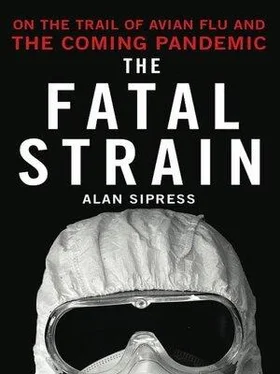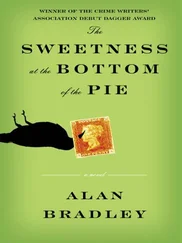Uyeki delicately advised the family that he wanted to take a sample.
“No blood,” one relative objected.
“I’m not going to draw blood,” Uyeki assured them. His aim was to swab the man’s nose and throat.
“No equipment,” a relative insisted, making clear they’d be horribly offended if Uyeki donned his protective gear.
It was a terrible demand. This was a monster of a virus that had killed most of those it infected. Flipping a coin would give better odds of survival. It was so deadly that scientists studying the virus were required to wear protective suits and work in special limited-access laboratories behind double doors with reverse ventilation to siphon off contaminated air. In the field, investigators were instructed to wear full outfits, including respirator masks, goggles, surgical caps and gowns, shoe coverings, and gloves. Uyeki usually snapped on three layers of gloves just to be sure. He always carried the complete gear in his backpack. This was going to be a tough negotiation.
“OK,” Uyeki offered, “I won’t wear a gown and I won’t wear goggles.” He would compromise. “But I’m going to wear a respirator and gloves.” He figured the main hazard would be breathing in the virus or getting it on his bare flesh.
“Nothing,” the relative repeated.
“No, this is what I’m going to wear,” Uyeki responded, motioning to his face and hands.
They went back and forth. Eventually the family relented. Uyeki slipped on what he considered the minimum protection, a mask and gloves.
Uyeki had wanted one of the Indonesian doctors to help him take samples. But his colleague was petrified, rightfully so. He was just a local country doctor who had never confronted such a cruel and exotic killer. Uyeki tried to reassure him. Uyeki produced another mask and pair of gloves from his backpack and passed them to his reluctant partner, then explained step-by-step what they were about to do.
On Uyeki’s instruction, the Indonesian physician lifted a Q-tip-like swab to Dowes’s left nostril and gingerly inserted it. Then he handed it back to Uyeki, who carefully snapped off the top, placed it into a tube containing sterile media for transporting virus samples, and screwed on the cap.
Next Uyeki sampled the right nostril himself, repeating the procedure.
Finally Uyeki prepared to take the throat specimen. This would be tougher. He would have to reach into the windpipe with the swab and fish out a glob of mucus. It would be absolutely loaded with virus. The pathogen had already been replicating inside its host for a week, and Dowes would be teeming with infection.
Uyeki squatted beside him and leaned right in. The doctor’s eyes were just inches from those of his patient. Uyeki lifted the swab. Then, he carefully inserted it through the open mouth and down Dowes’s throat.
The sensation must have tickled. For at that very moment, Dowes coughed. And when he did, it was right in Uyeki’s face.
Uyeki didn’t blanch. But inside, his stomach dropped. “Oh, this is not good,” Uyeki fretted to himself. Despite the mask, most of his face was exposed. His mind raced. He instantly thought about his unprotected eyes. He knew other types of avian flu viruses had been contracted through the eyes. Could the same be true for this strain?
He tried to stay focused. He had long since learned to remain calm no matter what. Countless times in his career he had resuscitated children when one slight miscue or false start might mean their death. This time he stared past his own mortality. Later, after leaving the village, he would urgently dose himself with antiviral drugs, taking four times the usual amount prescribed for prophylaxis, and acknowledge he’d made a mistake. He would promise himself never to forgo goggles again.
But now he had to rein in his rising anxiety. Slowly, he withdrew the swab from the Dowes’s mouth and backed away.
Uyeki placed the final, hard-won sample in a tube. With a Magic Marker, he labeled all the specimens. Next, he removed his gloves, then those of his Indonesian partner. He stuffed them in a bag he had brought specifically for disposing of dirty material. He sealed it tight.
Then he turned back to the row of family members seated along the wall with another request. He told them he now wanted to briefly examine Dowes and asked for permission.
“All I want to do is listen,” Uyeki appealed, showing them his stethoscope. “I just want to listen to him. No blood. I’m not going to do a full exam.” They agreed.
Squatting next to the mattress, he listened to Dowes’s chest. He listened with the patient sitting up and with the patient lying down. Uyeki heard an odd crackling sound, a kind of coarse gurgling each time Dowes inhaled and each time he exhaled. Uyeki had heard this in other patients, but never this loud. It was the sound of fluid, of a man drowning.
“He has pneumonia and he has it in both lungs,” he reported to the relatives. “I strongly recommend he go to a hospital.”
From beneath his straight black bangs, Uyeki’s detective eyes watched them, trying to gauge their reaction. But he knew what the answer would be. The relatives refused. They insisted that Dowes had to complete two more days of traditional treatment. Uyeki had no choice but to defer to their wishes. He didn’t want to make a scene. Nor did he have any way of forcing them to comply. Though he had come to the village with a security officer, the escort’s charge was limited to keeping Uyeki safe should the locals turn unruly. So after only two hours in the village, the medical team was back on the road in their four-wheel-drive vehicle, skirting the volcano, bound for the district capital of Kabanjahe twenty-five miles away.
But before they left, Uyeki urged the relatives to get Dowes to a hospital if his condition worsened. Uyeki suspected it would. It was clear Dowes was going to die. Uyeki did not realize how quickly.
It had been nearly a year since Indonesia had confirmed its first human cases of bird flu. A government auditor in the suburbs of Jakarta and his two young daughters had died abruptly in July 2005. The outbreak was unnerving on several counts. Not only were disease specialists unable to determine the original source of infection despite weeks of investigation, but the sequence of the three cases strongly suggested that the virus had been passed from at least one victim to another. Perhaps most worrisome was that the virus was now striking people in Indonesia at all. The strain had already been exacting a toll elsewhere in Southeast Asia, but Indonesia, a country of vast size, sprawl, and poverty, was the most daunting front so far.
Then, less than a month later, the world got some surprisingly good news from a pair of international research teams. By applying cold, hard numbers and sophisticated computer models to the outbreak in Southeast Asia, the two teams had each determined that the world could nip a human flu epidemic in the bud given the right mix of antiviral drugs, quarantines, and social controls. This would be unprecedented. Mankind had never before been able to stem an emerging influenza pandemic but throughout history always had to ride out the storm, waiting for the plague to burn itself out. Now, armed with high-speed computers, advanced statistics, and modern medical science, humanity might be able to bend nature to its will.
At Imperial College London, computational biologist Neil M. Ferguson led a group of researchers in simulating an emerging epidemic in rural Thailand. They chose Thailand because detailed demographic data was available. But the researchers said the conclusions could equally apply to similar low-density communities in Southeast Asia. Starting with a single human infection, Ferguson and his colleagues found that the virus remained limited to the local area for about thirty days before shooting like buckshot across the rest of the country over the following two months. They said this created an opportunity to contain a nascent pandemic at its source if about 2 million courses of the antiviral drug oseltamivir were rushed to the scene and dispensed to those within three miles of the initial outbreak. Oseltamivir is marketed by the Swiss drug company F. Hoffmann-La Roche Ltd. under the brand name Tamiflu. Officials would also have to shutter schools and workplaces to limit human contact and would have to place the entire area under quarantine.
Читать дальше











